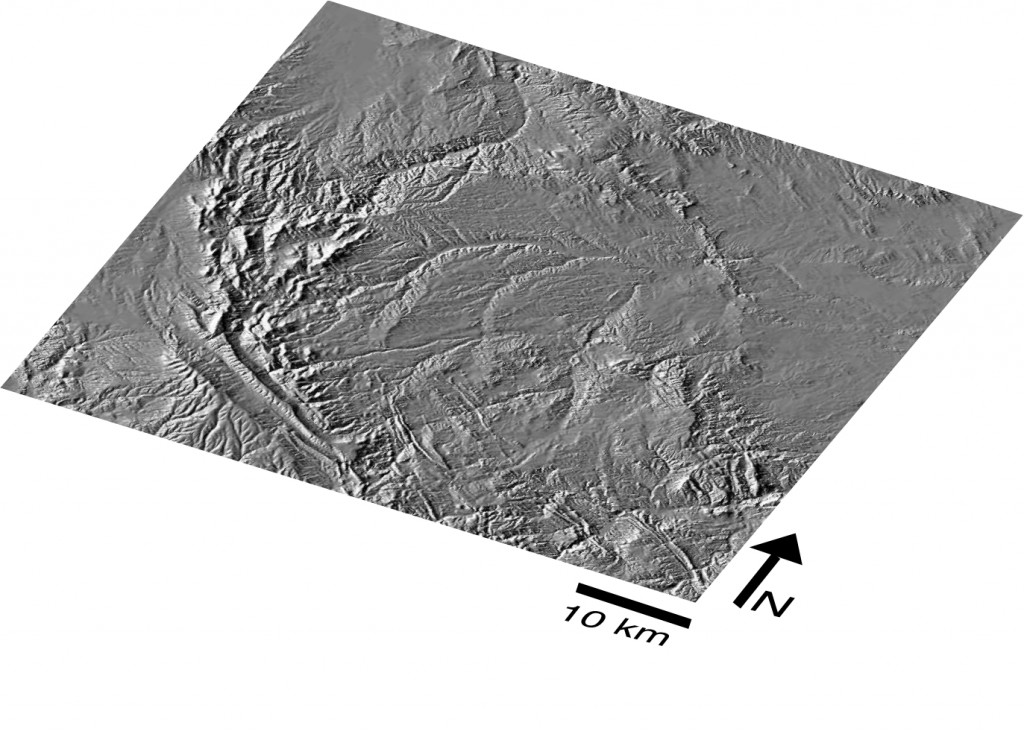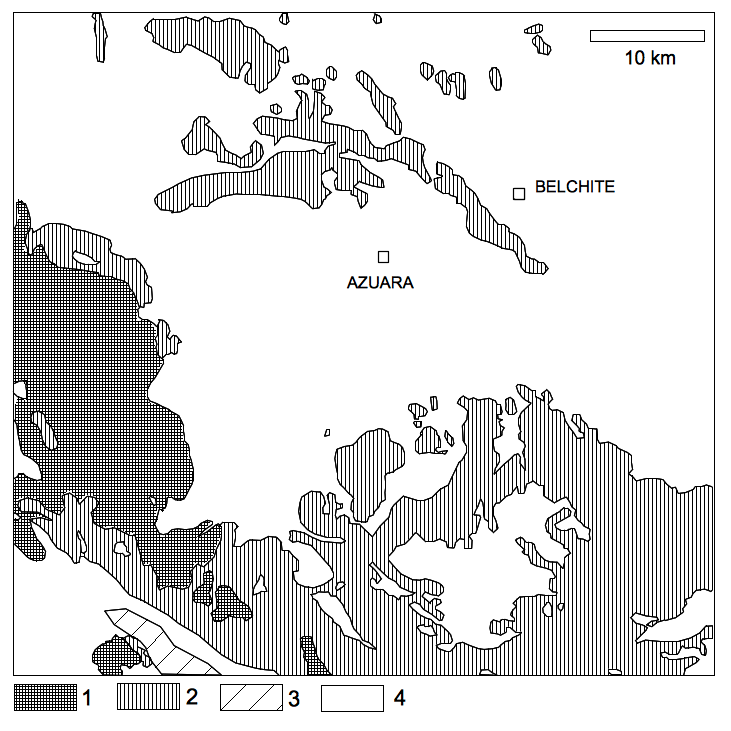Introduction, geologic overview and references
The roughly 40-km diameter Azuara impact structure (Fig. 1) is located in northeast Spain 50 km south of Zaragoza (see Azuara from space). From stratigraphic considerations, its age is estimated to be Upper Eocene or Oligocene (Fig. 2). Except for very small magmatic intrusions, the target was purely sedimentary, which is a rare case with very large impact structures. The target was composed of the roughly 10 km thick Paleozoic core of the Iberian chain and the Mesozoic cover overlain by Tertiary molasse sediments of probably 1000 – 2000 m thickness. This prominent thickness of more or less loosely bound sediments and the carbonate rocks prevailing in the sedimentary sequence are related to many peculiarities of the Azuara structure such as relics of carbonate melt, a special facies of the impact ejecta, and distinct breccia dikes.
Young post-impact sediments widely hamper the investigation of the central part of the Azuara structure. Therefore, most outcrops concentrate on the rim region (Fig. 2) where they are very abundant enabling excellent insight into the geology of the impact process.
 Fig. 1. Morphological signature of the Azuara structure taken from the digital map of Spain, 1 : 250,000. The image has been performed by Manuel Cabedo.
Fig. 1. Morphological signature of the Azuara structure taken from the digital map of Spain, 1 : 250,000. The image has been performed by Manuel Cabedo.
 Fig. 2. Stratigraphic column of the Azuara impact target.
Fig. 2. Stratigraphic column of the Azuara impact target.
 Fig. 3. Geological sketch map of the Azuara impact structure. 1 = Paleozoic, 2 = Mesozoic, 3 = Pelarda Fm. ejecta, 4 = Cenozoic. Modified from Ernstson et al. (2002).
Fig. 3. Geological sketch map of the Azuara impact structure. 1 = Paleozoic, 2 = Mesozoic, 3 = Pelarda Fm. ejecta, 4 = Cenozoic. Modified from Ernstson et al. (2002).
The impact hypothesis for the Azuara structure was first established by Ernstson et al. (1985). Until then, the structure attracted practically no interest except for a paper by Carls (1983), wherein a tectonic Azuara block has been mentioned. Later, Spanish geologists in general considered the Azuara structure a basin which was formed by syn-tectonic sedimentation (e.g., Aurell et al. 1992, 1993, 1994). More recently, the Azuara structure has also been suggested as to originate from a granitic intrusion (Sanchez Cela 1997).
The model of a giant meteorite impact is based on a very detailed geological mapping, geophysical measurements, photo lineation studies, and petrographic analyses of about 1,000 thin sections. From these investigations (see list of references), the impact is documented by gravity negative anomalies, abundant monomictic and polymictic breccias and breccia dikes (frequently displaying shock-metamorphic effects such as diaplectic glass, melt particles, all kinds of planar deformation features [PDFs] , extended and thick megabreccias, a large quantity of dislocated megablocks, hydrothermal signature (Siegert 1997), and extended and thick impact ejecta (see the submenu).
Among these observations, especially the shock-metamorphic effects indicating extremely high pressures ( several 100 kilobars = several 10 GPa) and temperatures (> 1000 °C) are basically incompatible with models of an endogenetic origin (by tectonics, syn-tectonic sedimentation, granitic intrusion) of the Azuara structure.
The following list of references comprises both papers written by authors favoring an impact origin and authors basically suggesting an endogenic origin of the impact features.
References
Anguita, F., Márquez, A. & Claudin, F. (2000). Réplica al artículo “controversia científica para el aula: ¿Tiene la cubeta de Azuara un origen extraterrestre” por A.L. Cortés Gracia y M.B. Martínez Peña (ECT, 7.2: 143-157). Enseñanza de las Ciencias de la Tierra. 8.2:148-153.
Aurell, M., Meléndez, A., San Roman, J., Guimera, A., Roca, E., Salas, R., Alonso, A. and Mas, R. 1992. Tectónica sinsedimentaria distensiva en el límite Triásico-Jurásico en la Cordillera Ibérica. Actas III Cong. Geol. Esp., 1, 50-54.
Aurell, M., González, A., Pérez, A., Guimerà, J., Casas, A. & Salas, R. (1993). Discusión of “The Azuara impact structure (Spain): New insights from geophysical and geological investigations” by K. Ernstson & J. Fiebag. Geologische Rundschau. 82: 750-755.
Aurell, M. (1994). Discusión sobre algunas de las evidencias presentadas a favor del impacto meteorítico de Azuara. In: Extinción y registro fósil (E. Molina, ed.). Cuadernos interdisciplinares. 5: 59-74. Seminario Interdisciplinar de la Universidad de Zaragoza. Zaragoza.
Carls, P. & Monninger, W (1974). Ein block-Konglomerat im Tertiär der östlichen Iberischen Ketten (Spanien). N. Jb. Geol. Paläont. Abh. 145: 1-16.
Carls (1983): La zona asturoccidental-leonesa en Aragon y el macizo del Ebro como prolongación del macizo cantabrico. In: Libro Jubilar J. M. Ríos, (Comisión Nacional de Geologia, ed.), Contribuciones sobre temas generales, Inst. Geol. Miner. Espana, III, 11—32, Madrid.
Casas, A.M., Casas, A., Pérez, A., Tena, S., Barrier, L., Gapais, D. & Nalpas, T. (2000). Syn-tectonic sedimentation and thrust-and-fold kinematics at the intramountain Montalbán Basin (northern Iberian Chain, Spain). Geodinamica Acta. 1: 1-17.
Claudin, K., Ernstson, K., Rampino, M.R., and Anguita, F.: Striae, polish, imprints, rotated fractures, and related features in the Puerto Mínguez impact ejecta (NE Spain). Abstracts, 6th ESF IMPACT workshop, Impact Markers in the Stratigraphic record, pp. 15-16, 2001.
Claudin, F. y Ernstson, K. (2003): Gelogía planetaria y geología regional: El debate sobre un impacto múltiple en Aragón. Con un anexo: Nuevos datos sobre la estructura de Azuara y zonas limítrofes: Una cadena de cráteres de impacto. – Ensenanza de las Ciencias de la Tierra, 11/3, 202-212.
Cortés, A.L. & Martínez, M.B. (1999). Controversia científica para el aula: ¿ tiene la cubeta de Azuara un origen extraterrestre?. Enseñanza de las Ciencias de la Tierra. 7.2: 143-157.
Cortés, A.L. y Martínez, M.B. (2001). Réplica a la discusión de F.Anguita, A.Márquez y F.Claudin (ECT, 8.2, 148-153) al artículo “Controversia científica para el aula: ¿tiene la cubeta de Azuara un origen extraterrestre? . ECT. 9.1:70-75.
Cortés, A.L., Díaz-Martínez, E., Sanz-Rubio, E., Martínez-Frías, J. & Fernández, C (2002 a). Cosmic impact verus terrestrial origin of the Azuara structure (Spain): A review. Meteoritics Planet. Sci. 37: 875-894.
Cortés, A. L., Díaz-Martínez, E.,González-Casado, J.M., Aurell, M. & Casas-Sainz, A.M. (2002b). Cratered cobbles in Triassic Buntsandstein conglomerates in northeastern Spain: An indicator of shock deformation in the vicinity of large impacts: Comment and Reply. Geology: Vol. 30, No. 1, pp. 91–91.
Diaz Martínez, E., Sanz Rubio, E. & Martinez Frias, J (2002): Sedimentary record of impact events in Spain. Geological Society of America. Special Paper 356: 551-562.
Ernstson, K., Hamman, W., Fiebag, J. & Graup, G.: Evidence of an impact origin for the Azuara structure (Spain). – Earth Planet.Sci.Let., 74, 361-370, 1985.
Ernstson, K., Feld, H. & Fiebag, J.: Impact hypothesis for the Azuara structure (Spain) strengthened. – Meteoritical Society Meeting, Newcastle upon Tyne, 1987. – Meteoritics, 22, 373, 1987.
Ernstson, K. & Claudin, F.: Pelarda Formation (Eastern Iberian Cains, NE Spain): Ejecta of the Azuara impact structure. – N.Jb.Geol.Paläont.Mh., 1990, 581-599, 1990.
Ernstson, K.: Azuara: un impacto meteoritico! – Astrum, 97, 13, 1991.
Ernstson, K. & Fiebag, J.: The Azuara impact structure (Spain): new insights from geophysical and geological investigations. – Geol.Rundschau, 81/2, 403-427, 1992.
Ernstson, K. & Fiebag, J.: Reply to discussion of “The Azuara impact structure (Spain): new insights from geophysical and geological investigations” by K.Ernstson and J.Fiebag – Geol.Rundschau, 82, 756-759, 1993.
Ernstson,K.: Looking for Geological Catastrophes: The Azuara Impact Case. – In: Extinción y registro fósil (Extinction and the fossil record, E. Molina, ed.), Cuadernos Interdisciplinares No. 5, 31-57, SIUZ, 1994.
Ernstson, K., Rampino, M.R., Anguita, F., Hiltl, M., and Siegert, I.: Shock deformation of autochthonous conglomerates near the Azuara impact structure, Spain: Geological Society of America Abstracts with Program, v. 31, p. A-122., 1999.
Ernstson, K., Rampino, M.R. & Hiltl, M.: Cratering of cobbles in Triassic Buntsandstein conglomerates in NE Spain: Shock deformation of in-situ deposits in the vicinity of large impacts. Geology, v. 29, no.1, 11-14, 2001
Ernstson, K., Rampino, M.R., and Hiltl, M.: Shock-induced spallation in Triassic Buntsandstein conglomerates (Spain): an impact marker in the vicinity of large impacts. Abstracts, 6th ESF IMPACT workshop, Impact Markers in the Stratigraphic record, pp. 25-26, 2001.
Ernstson, K., Claudin, F., Schüssler, U., Anguita, F, and Ernstson, T.: Impact melt rocks, shock metamorphism, and structural features in the Rubielos de la Cérida structure, Spain: evidence of a companion to the Azuara impact structure. Abstracts, 6th ESF IMPACT workshop, Impact Markers in the Stratigraphic record, pp. 23-24, 2001.
Ernstson, K. and Hiltl, M. (2002): Cratering of cobbles in Triassic Buntsandstein conglomerates in NE Spain: Shock deformation of in-situ deposits in the vicinity of large impacts. – Reply to discussion by H. Stel, H. Rondeel, and J. Smit.- Geology, v. 30, 1051-1052, 2002.
Ernstson, K., Claudin, F., Schüssler, U. & Hradil, K. (2002). The mid-Tertiary Azuara and Rubielos de la Cérida paired impact structures (Spain). Treballs del Museu de Geologia de Barcelona. 11: 5-65.
Ernstson, K., Schüssler, U., Claudin, F. & Ernstson, T. (2003). An impact crater chain in northern Spain. Meteorite, 9, no 3, 35-39.
Ernstson, K. (2004). Regmaglypts on clasts from impact ejecta. Meteorite, 10, no 1, 41-42.
Hradil, K., Schüssler, U., and Ernstson, K.: Silicate, phosphate and carbonate melts as indicators for an impact-related high-temperature influence on sedimentary rocks of the Rubielos de la Cérida structure, Spain. Abstracts, 6th ESF IMPACT workshop, Impact Markers in the Stratigraphic record, pp. 49-50, 2001.
Müller, H. & Ernstson, K.: Curved joint sets: Indication of impact-induced fracturing. – In: Mechanics of Jointed and Faulted Rock, H.P.Rossmanith, ed., 257-263, Balkema, Rotterdam 1990.
Rampino, M. R. (1997). El impacto de Azuara y sus efectos. Universo, III, no 29, 48-50.
Sanchez Cela, V. (1997) “La estructura circular de Azuara (Zaragoza). Origen endógeno versus impacto.” Boletín Geológico y Minero 108: 121-128.
Sanz-Rubio, E., Díaz-Martínez, E., Martínez-Frías, J. & Fernández-Martín, C. (2001). Stratigraphy of the Calatayud-Montalban basin: Implications for the interpretation of the Azuara and the Rubielos de la Cérida structures (NE Spain), in: Impact markers in the stratigraphic record, 6th ESF-IMPACT workshop Granada, abstract book: 111-112.
Siegert, I. (1997): Micro-thermometric and petrographic investigations of quartzites from the Azuara-Rubielos de la Cérida doublet structure (Spain). Diploma thesis, 72 pp., Universität Bremen (in German).
Steel, Harry, Harm Rondeel, Jan Smit (2002). Cratered cobbles in Triassic Buntsandstein conglomerates in northeastern Spain: An indicator of shock deformation in the vicinity of large impacts: Comment and Reply. Geology, 30, no 11, 1051-1051.
Besides the papers in the reference list, we would like to point to the following theses about the Azuara impact:
FIEBAG, J. (1988): Contributions to the geology of the Azuara structure: Geological mapping in the area between Herrera de los Navarros and Aladrén and SE of Almonacid de la Cuba, and special investigations of the breccias and breccia dikes in the light of the impact origin of the Azuara structure. – Doctoral thesis, Univ. Würzburg, 271 pp., Würzburg (in German).
Johannes Fiebag († 1999) has markedly pioneered the geologic work in the Azuara impact structure. Several pictures of this homepage have either been taken by himself or have been taken from rocks of his personal collection.
Bärle, F. (1988): Geological investigations at the SW rim of the Azuara structure (NE Spain): Geological mapping (1 : 10,000 scale) and special tectonic investigations. – Unpublished Diploma Thesis, Univ. Würzburg, 94 pp., Würzburg (in German).
GWOSDEK, C. (1988): Geological investigations at the SE rim of the Azuara structure (NE Spain): Geological mapping (1 : 10,000 scale) in the environs of Moneva with special reference to the tectonic inventory. – Unpublished Diploma Thesis, Univ. Würzburg, 108 pp., Würzburg (in German).
HUNOLTSTEIN-BUNJEVAC, D. v. (1989): Geological investigations at the SE rim of the Azuara structure (NE Spain): Geological mapping (1 : 10,000 scale) in the environs of Moyuela with special reference to structural features. – Unpublished Diploma Thesis, Univ. Würzburg, 111 pp., Würzburg (in German).
KATSCHOREK, T. (1990): Geological investigations at the N rim of the Azuara structure (NE Spain): Geological mapping (1 : 20,000 scale) of the area between Fuendetodos and Belchite with special reference to structural features. – Unpublished Diploma Thesis, Univ. Würzburg, 198 pp., Würzburg (in German).
König, R. (1988): Geological investigations at the SW rim of the Azuara structure (NE Spain): Geological mapping (1 : 10,000 scale) and special tectonic investigations. – Unpublished Diploma Thesis, Univ. Würzburg, 142 pp., Würzburg (in German).
LINNEWEBER, 5. (1988): Geological investigations at the SE rim of the Azuara structure (NE Spain): Geological mapping (1 : 10,000 scale) of the area between Blesa and Muniesa with special reference to tectonic features. – Unpublished Diploma Thesis, Univ. Würzburg, 103 pp., Würzburg (in German).
Mayer, G. (1991): Geological investigations at the SE rim of the Azuara structure (NE Spain): Geological mapping (1 : 20,000 scale) with special reference to tectonic features and in the light of the impact origin of the structure. – Unpublished Diploma Thesis, Univ. Würzburg, 216 pp., Würzburg (in German).
Müller, H. (1989): Geological investigations at the SE rim of the Azuara structure (NE Spain): Geological mapping (1 : 20,000 scale) between Ventas de Muniesa and Moneva with special reference to facies and structural features. – Unpublished Diploma Thesis, Univ. Würzburg, 167 pp., Würzburg (in German).
Waasmaier, E. (1988): Geological investigations at the S rim of the Azuara structure (NE Spain): Geological mapping (1 : 10,000 scale) west of Blesa with special reference to tectonic features. – Unpublished Diploma Thesis, Univ. Würzburg, 108 pp., Würzburg (in German).
Siegert. I. (1997): Thermomicrometrical and petrographical investigations of quartzites from the Azuara – Rubielos de la Cérida doublet structure (Spain). – Unpublished Diploma Thesis, Univ. Bremen, 72 pp., Bremen (in German).
An excellent and very detailed geological mapping on a 1 : 10,000 scale of the N rim of the Azuara structure between Aguilón and Fuendetodos has been performed by H.Feld within the frame of a DFG (German Science Foundation) research program.






































































